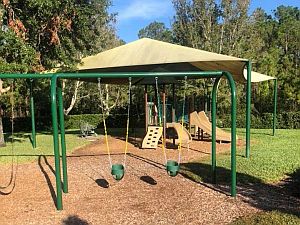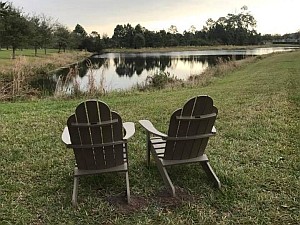
 Ponds & Wetlands
Ponds & Wetlands
Harmony Master Drainage Infrastructure
The master drainage infrastructure for Harmony consists of the ponds, the control structures, and the underground interconnecting piping that connects the ponds to each other and to the adjacent wetlands. The system is designed to achieve the following six goals:
- Maintain water quality
- Maintain historic water levels and flows
- Preserve historic storage for 100-year storm event
- Provide positive drainage for streets, parks, and neighborhoods
- Serve as an amenity to the community
- Provide wildlife habitat
The 44 existing and 3 additional future ponds that collectively create the Harmony master drainage system work in concert with each other and their surrounding basins so that the drainage system meets all six of the above-described design goals. Although some ponds may seem remote from the neighborhoods, the water quality treatment, peak discharge attenuation and compensatory storage provided by those ponds is considered cumulatively as part of the entire master system.
Click here to view the District Ponds & Drainage System Map.
Click here to view the CDD Field Maintenance Ponds ID Map.
{High resolution graphics — zoom-in to see details.}
 Goals 1 through 4 are achieved by meeting and exceeding current Federal, State, and County permitting requirements, and all environmental protection & stormwater regulations. The South Florida Water Management District (SFWMD) issued a master permit in 2001 approving the design of the proposed master drainage system, as shown on Harmony’s Master Drainage Plan. SFWMD requires, as a condition of its approval, that a public entity (either Osceola County or an applicable CDD) provide perpetual maintenance of the drainage infrastructure. The Harmony CDD is the designated & approved entity responsible for the continued operation/maintenance of the master drainage system. This obligation includes the maintenance of not only the pond banks & the structural integrity of the pond berms, but also the underground piping systems and the discharge & control structures.
Goals 1 through 4 are achieved by meeting and exceeding current Federal, State, and County permitting requirements, and all environmental protection & stormwater regulations. The South Florida Water Management District (SFWMD) issued a master permit in 2001 approving the design of the proposed master drainage system, as shown on Harmony’s Master Drainage Plan. SFWMD requires, as a condition of its approval, that a public entity (either Osceola County or an applicable CDD) provide perpetual maintenance of the drainage infrastructure. The Harmony CDD is the designated & approved entity responsible for the continued operation/maintenance of the master drainage system. This obligation includes the maintenance of not only the pond banks & the structural integrity of the pond berms, but also the underground piping systems and the discharge & control structures.
Although the HCDD is ultimately responsible for maintenance of all community ponds, the Harmony Golf Preserve provides routine mowing and landscape maintenance of the ponds within or adjacent to the golf course. All of the drainage ponds and structures that are located within the golf course are within a maintenance easement granting the District the right to perform either routine or emergency maintenance as may be required.
Click here to read the blanket Drainage Easement w/ Amendments 1-thru-4.
Stormwater Management Goals:
GOAL #1 – Maintain water quality
The drainage ponds must be designed to provide water quality treatment so that runoff from the developed areas is treated to remove pollutants prior to discharge into the surrounding wetlands. This function is commonly referred to as “Water Quality Treatment”. Treatment is achieved by detaining the water for a time sufficient to allow particulates to settle to the bottom. A skimmer device, included as part of the outfall system, prevents trace amounts of oil or other floating pollutants from being discharged from the pond. Vegetation around the shore line and supplemental littoral zones serve to absorb phosphorous and nitrogen from the water. By the thus provided water quality treatment, the long-term water quality of the natural lakes and wetlands surrounding Harmony will not be degraded as a result of the adjacent developments.
GOAL #2 – Maintain historic water levels and flows
When development occurs, the impervious areas (e.g., rooftops, sidewalks, and streets) significantly increase the quantity and rate of runoff that is generated from site. State and County regulations require that the drainage ponds limit their rate of discharge so as to not exceed the rate of discharge that existed in the pre-development condition. This is referred to as “Peak Discharge Attenuation”. By providing peak discharge attenuation, the existing hydrologic function of the surrounding lakes (Buck and Cat) and wetlands are preserved so that their average daily and historic high water elevations and flows are not altered. This also prevents flooding of downstream areas that would occur due to increase runoff if not attenuated at the source.
GOAL #3 – Preserve historic storage for 100-year storm event
Prior to development, portions of the Harmony property were below the highest historic 100-year flood elevations of Buck Lake and Cat Lake. To allow development of these areas, the ground surface had to be raised so that the area was no longer lower than the 100-year flood elevation of the adjacent lake or wetlands. However, by raising these areas, the storage volume available to the adjacent wetland or lake has been displaced. The master drainage system has to provide additional storage capacity to replace the capacity lost due to filling low-lying areas that were originally within the flood plain. This is referred to as “Compensatory Storage”.
GOAL #4 – Provide positive drainage for streets, parks, and neighborhoods
While providing adequate treatment volume (Goal #1), peak discharge attenuation (Goal #2), and compensatory storage (Goal #3), the drainage ponds must also be large enough so that they contain all the runoff from the contributing areas while not creating “back ups” that flood streets or homes. In order to achieve this goal, the ponds must have sufficient available volume to hold all of the runoff from developed property and store that water such that the criteria of goals 1, 2, and 3 are not compromised.
GOAL #5 – Serve as an amenity to the community
 Once the number, locations, and sizes of the required ponds have been determined, the final design is completed in a manner so that the ponds will be viewed as a public facility. A comparison can be made with County FDOT constructed and maintained ponds vs. ponds designed especially with the District in mind. Infrastructure drainage ponds for FDOT are typically designed to meet the first four goals only. The pond will usually be an engineered polygon with a chain link fence to keep the public away. The pond is mowed minimally and tall grass and weeds are common. In contrast, the ponds in Harmony are designed to be both aesthetically pleasing and serve as an enhancement to the community; in addition to satisfying the first four criteria.
Once the number, locations, and sizes of the required ponds have been determined, the final design is completed in a manner so that the ponds will be viewed as a public facility. A comparison can be made with County FDOT constructed and maintained ponds vs. ponds designed especially with the District in mind. Infrastructure drainage ponds for FDOT are typically designed to meet the first four goals only. The pond will usually be an engineered polygon with a chain link fence to keep the public away. The pond is mowed minimally and tall grass and weeds are common. In contrast, the ponds in Harmony are designed to be both aesthetically pleasing and serve as an enhancement to the community; in addition to satisfying the first four criteria.
GOAL #6 – Provide wildlife habitat
Many of the retention ponds within the District include large planted littoral zones that serve as nesting sites for native birds like Sand Hill cranes, and as flight resting areas for migratory fowl like ducks & geese. All of these ponds provide excellent natural habitat for a wide variety of native species, ranging from small (frogs) to large (alligators). This wildlife menagerie contributes to the charm of the District and only in the most extreme cases should it be disturbed. Should that be necessary, please follow the guidelines set forth in the Harmony CDD Nuisance Alligator Removal Procedure.







